8 Concrete Ways to Actually Get More Done During the Work Day
by Ana Gotter • August 2, 2017
Productivity is important to everyone, but it’s especially important when your income is immediately and directly impacted by how much you get done in a single day.
There’s plenty of articles out there promising methods to increase productivity, with tips like “focus on your tasks,” but they often lack actual tactics for how to actually accomplish this. Theory is fine, but actionable information is more useful.
I wanted to help with that, so in this post, I’m going to share eight specific, concrete ways to actually increase your productivity and get more done during the work day.
1. Get Your Day Started Before Work
I think we’ve all been guilty of having those mornings where we come into the office barely on time, without having drunk our coffee, had breakfast, or taken the time to mentally prepare for the work day. Unfortunately, when your day starts at work, you don’t leave yourself any time to get your ducks in a row before questions, calls and tasks start rolling in.

The solution? Wake up a little earlier. Give yourself time to completely wake up, have a coffee in peace and quiet or simply eat a good breakfast before the chaos begins.
It’s also a good idea get at least 15-30 minutes of exercise in before work, whether that’s running around your block or doing yoga at home. Morning exercise can help increase your productivity, concentration and focus during the day. It’s also a powerful stress reliever, which is also a big plus.
2. Shut Your Personal Phone in a Drawer
When you’re waiting for a friend at happy hour, or in the doctor’s waiting room, or just when you have nervous energy, what do you do? If you’re like most people, you pick up your phone. I’ve seen people pick up their phone, automatically open Facebook, and scroll rapidly through their feed without even really looking at it. It’s habit more than anything.
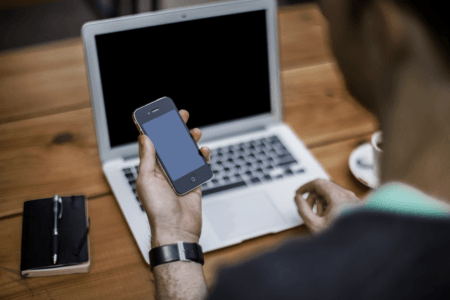
I’m guilty of idly fiddling with my phone and checking my email, even though I get my email plenty often on my desktop as it is. It’s a habit, and it’s a quick one, but those small moments of idly fiddling add up quickly.
If possible, shut your personal phone in a drawer or put it out of reach so you don’t find yourself picking it out just out of habit. This one will be especially helpful for Millennials, whose phones may as well be glued to their hands most of the time.
3. Keep Your Workspace Organized
I’m what I like to call a “procrasti-cleaner.” If I have a project I really don’t want to work on, I have trouble focusing until my work area is perfectly clean and organized. I’ll end up cleaning on the days of a big project if it’s even a little cluttered.
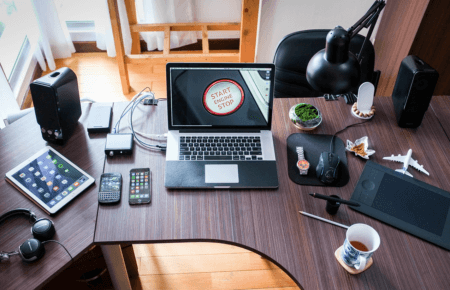
While cleaning is good, cleaning when you should really be working can eat into your productivity.
To solve this problem, put the things you need regularly within immediate reach. If you regularly jot down notes on a notepad, keep both the pad and a pen close by instead of buried in a drawer.
Aside from this, though, keep your desk clean and clutter-free. Use a simple but efficient system to keep physical documents like contracts organized but out of sight. You should even organize your desk drawers strategically. Put what you use more regularly in the top drawers nearest to you, so they’re easily accessible.
Organizing your desk will keep you from idly shuffling things around or re-organizing, and it makes it easier to focus. This will boost productivity during the day, especially when you don’t have to go digging for files or documents since you’ll already know exactly where they are.
4. Knock Out Your Hardest Task First
I hate the feeling of having a big, dreaded project looming over my head. It’s easy to spend more time procrastinating and dreading doing the work than it is to just jump in and do it.
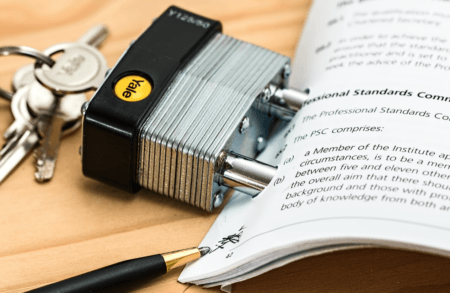
As it turns out, knocking out your hardest task first is the best way to get more done with your workday. You won’t stall to avoid getting to work on it, and you’ll be able to tackle your other tasks worry-free for the rest of the day. This will increase productivity significantly, and both your mood and stress levels will benefit, too.
5. Install Distraction-Blocking Extensions
Most of us have some site that distracts us more than others. For many, it’s Facebook. If I get drawn into a site with personal essays, I might not resurface for a little while. Whenever possible, it’s best to use distraction-blocking extensions and apps to keep yourself off these sites during workhours.
Sometimes this is a challenge. Agencies that need to do work on social media for clients, for example, have the difficult task of not getting sucked into their personal newsfeeds. In general, though, most people will be able to block the sites that distract them most either on mobile or desktop.
My favorite tool, which I use daily, is the WasteNoTime browser extension. It lets you establish blocked sites, and if you want to allow a certain amount of time (like 5 minutes) on the blocked sites. If you visit a blocked site, they’ll have a nice big message saying “Shouldn’t you be working?” along with a slightly passive-aggressive message about not procrastinating.
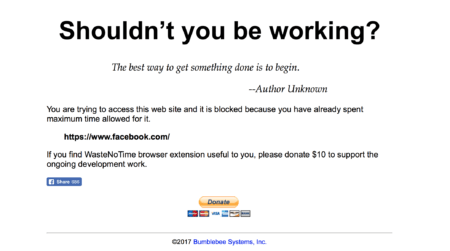
Other potential tools include:
- Cold Turkey
- StayFocusd
- Freedom (works on desktop and mobile)
Ultimately, though, the effectiveness of any tool is limited by your commitment to using it. If you want to stop wasting time on distractions, you need to commit yourself to working during work time…and playing during play time.
6. Set Reminders for Break Time
Plenty of people could use timers to remind them that their break time is over, but if you’re reading this article, you may not be one of them. Instead, you may actually need timers to remind you to take your breaks in the first place.
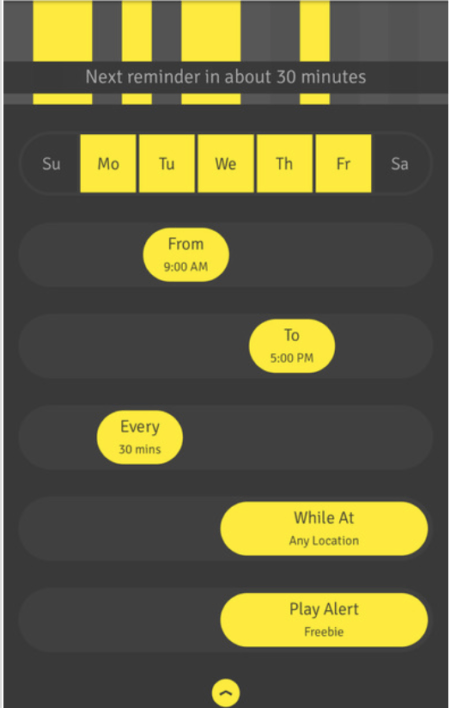
Stand Up! lets you schedule when you want to take your breaks.
This seems counterintuitive, but working through breaks can actually significantly decrease your productivity, both immediately and long-term.
It’s important to take breaks regularly throughout the day, even if it’s just a five-minute break to get up, walk around, and stretch your legs. According to some research, you’ll be at your most effective if you take a brief break after every 90 minutes.
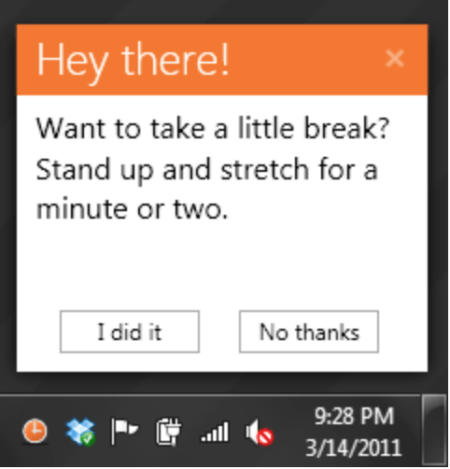
A reminder from BreakTaker.
Some people (myself included) benefit from scheduling breaks into the day, and even setting timers to remind us when it’s time to walk away for a few minutes. This may be particularly beneficial if you’ve got busy days full of meetings and client calls, and need to actually schedule breaks in and remember to take them exactly then.
If you think this could benefit you, a few apps that are great for this include:
- Stand Up! The Work Break Timer (iOS only)
- Randomly Remind Me (Android only)
- BreakTaker (windows)
It might seem like a fairly simple thing, but taking brief breaks at regular intervals can be one of the best ways to boost your productivity.
7. Use Activity Trackers
Want to see where you personally are losing too much time during the work day? There are some great tools that track the sites you visit and how long you spend on them.
RescueTime is how I realized I spent way too much time checking my email. I like to check it often so I can stay on top of my inbox and accommodate my schedule for last minute rush projects. But by using an RescueTime, I realized that out of simple compulsive habit, I was checking my email every two to five minutes when doing mentally strenuous research.
This was a major productivity interrupter, and once I made a conscious effort not to do this, I noticed that I was able to get a lot more done in a shorter time frame.
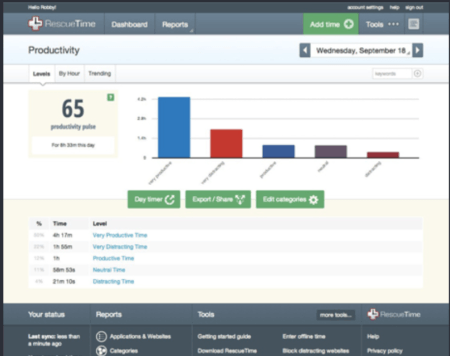
Activity trackers can help you identify your personal time-busters. They can also show you if you’re taking longer than you realized on projects you’re working on, allowing you to take that into account when mapping out your day. They can also help you see if you spend too much time jumping from project to project, which is another big productivity killer.
I highly recommend RescueTime as an activity tracker, because it can run in the background of your desktop or mobile device. If you want to combine this tip with tip #5, RescueTime can also block out distracting sites for you.
8. Leave Yourself Some Breadcrumbs
I once wrote a sentence that read “And that’s when I realized that the secret to sending your ads ROI skyrocketing is” and then I answered a last-minute call from a client. And guess what? When I finally got back to finishing my sentence, I had forgotten my breakthrough…
How I wish I’d left myself some breadcrumbs about my big insight!
Leaving yourself breadcrumbs is extremely easy to do when writing an article or a blog post, but it’s also easy to do with pretty much any type of task that can’t be accomplished in one sitting. Whether you’re developing a marketing strategy for a client or putting together a seasonal menu for your restaurant, you should leave yourself some bullet points explaining your train of thought before you get up if you must be interrupted.
Write down what next steps you need to take, and where your plan for the project was going before getting up. Otherwise, you may not be able to pick up where you left off, you could lose a near-genius idea, and you may even have to start all over. None of that lends itself well to productivity.
Final Thoughts
Even the most productive people can find new ways to increase efficiency and most of us have small ways we can tweak our days so we can get more done.
The eight tactics on this list address the most common productivity inhibitors most of us face on a daily basis. By eliminating-or reducing- these factors, you’d be surprised how much more you can get done in a single work day.
What do you think? How do you increase productivity and get more done during the work day? What strategies do you use to avoid distractions? Leave us a comment and let us know what you think!




